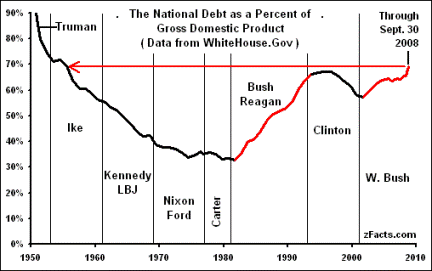US/gov/spending/by president
Jump to navigation
Jump to search
About
This article relates to comparisons of budgetary spending and policy across the different United States Presidential administrations.
Numbers
| Deficit | Debt | ||||
|---|---|---|---|---|---|
| Date | $ | %GDP | $ | %GDP | president |
| 1992-09-30 | 4,064,620,655,521.66 | Bush I leaving, Clinton incoming | |||
| 2000-09-30 | 5,674,178,209,886.86 | Clinton leaving, Bush II incoming | |||
| 2007-09-30 | 9,007,653,372,262.48 | Bush II leaving, Obama incoming | |||
Links
Reference
- Historical Debt Outstanding – Annual: year-by-year listings of the US public debt, going back to 1791
- earlier incarnation of that information
To Be Filed
- 2013-10-20 Celebrated chef Tom Colicchio tweets that relatively little debt accumulated under Barack Obama: FALSE
- 2013-07-24 Obama says deficit is falling at the fastest rate in 60 years: TRUE
- 2008-07-20 The United States Has Not Had A Balanced Budget Since 1957! (archived) explains how the claims of a surplus for Clinton are actually derived by leaving out part of the debt.
- Just For the Record by Dwight Meredith: multiple comparisons across Kennedy/Johnson, Nixon/Ford, Carter, Reagan, Bush I, and Clinton administrations. Summary (all figures are in 1996 dollars):
- Republican presidents increased the national debt by $3.8 trillion, with an average annual deficit of $190 billion.
- Democratic presidents increased the national debt by $719.5 billion, with an average annual deficit of $36 billion.
- The Latest Data on Bush's Spendthrift Ways: Percentage Changes in Real Discretionary Spending for LBJ, Nixon, Reagan, Clinton, and Bush
- How to Withstand the Coming Bush Economic Crisis: analysis of expected effects on the economy, written for portfolio investors
- President Reagan, Champion Budget-Cutter by Veronique de Rugy of the American Enterprise Institute
